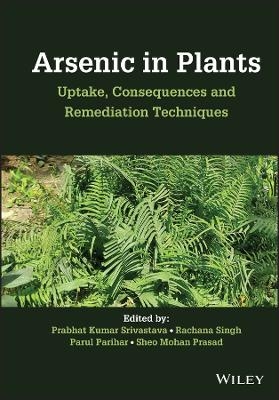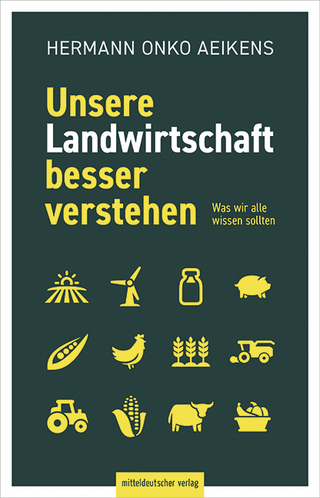
Arsenic in Plants
John Wiley & Sons Inc (Verlag)
978-1-119-79142-3 (ISBN)
Arsenic in Plants: Uptake, Consequences and Remediation Techniques provides comprehensive coverage of the subject, detailing arsenic in our environment, the usage of arsenicals in crop fields, phytotoxicity of arsenic and arsenic’s impact on the morphology, anatomy and quantitative and qualitative traits of different plant groups, including their physiology and biochemistry. The work emphasizes the occurrence of arsenic, its speciation and transportation in plants, and differences in mechanisms of tolerance in hyper-accumulator and non-accumulator plants.
Throughout the text, the highly qualified authors delve into every facet of the interaction of arsenic with plants, including the ionomics, genomics, transcriptomics and proteomics in relation to arsenic toxicity, impact of exogenous phytohormones and growth-regulating substances, management of arsenic contamination in the soil-plant continuum, phytoremediation of arsenic toxicity and physical removal of arsenic from water. General discussion has also been included on subjects such as the ways through which this metalloid affects plant and human systems.
Topics covered include:
Introduction and historical background of arsenic and the mechanism of arsenic transport and metabolism in plants
Arsenic-induced responses in plants, including impact on biochemical processes and different plant groups, from cyanobacteria to higher plants
The role of phytohormones, mineral nutrients, metabolites and signaling molecules in regulating arsenic-induced toxicity in plants
Genomic, proteomic, metabolomic, ionomic and transcriptional regulation during arsenic stress
Strategies to reduce the arsenic contamination in soil-plant systems and arsenic removal by phytoremediation techniques
Researchers, academics, and students of plant physiology, biotechnology, and agriculture will find valuable information in Arsenic in Plants to understand this pressing subject in full, along with its implications and how we can adapt our strategies and behaviors to promote reduced contamination through practical applications.
Prabhat Kumar Srivastava is an Assistant Professor of Botany in KS Saket PG College, Ayodhya, India. Rachana Singh is a Research Fellow in Ranjan Plant Physiology and Biochemistry Laboratory, Department of Botany, University of Allahabad, Prayagraj, India. Parul Parihar is an Assistant Professor at the Department of Botany, University of Allahabad, Prayagraj, Uttar Pradesh, India and at the Department of Bioscience and Biotechnology, Banasthali Vidyapith, Rajasthan, India. Sheo Mohan Prasad is a Professor of Botany at the University of Allahabad, Prayagraj, India.
List of Contributors xvi
Preface xxiv
1 An Introduction to Arsenic: Sources, Occurrence, and Speciation 1
Jabbar Khan, Govind Gupta, Riddhi Shrivastava, and Naveen Kumar Singh
1.1 Introduction 1
1.2 Status of Arsenic Contamination Around the World 2
1.3 Arsenic in the Aquatic and Terrestrial Environment 3
1.4 Absolute Bioavailability and Bioaccessibility of As in Plants and Agronomic Systems 4
1.5 Factors Determining Arsenic Speciation and Bioavailability in Soil 4
1.5.1 Effect of Redox Potential (Eh) and pH 4
1.5.2 Interactions with Al, Fe, and Mn Oxides and Oxyhydroxides 5
1.5.3 Interactions with P, Si, and Other Elements’ Concentration in the Soil 6
1.5.4 Interactions with Organic Matter 7
1.5.5 Clay Minerals and Other Factors 8
1.6 Arsenic Speciation in Plants 8
1.6.1 Methods of Determination of As and As Species in Plants 8
1.6.2 Uptake and Efflux Mechanism of Arsenate and Arsenite Species 9
1.6.3 Uptake and Efflux Mechanism of Methylated Arsenic Species 11
1.6.4 Arsenic and Rhizosphere Interaction (Mycorrhizal Fungi, Rhizofiltration) 12
1.7 Thiolated Arsenic and Bioavailability of Thiolated As Species in Plants and Terrestrial Environments 13
1.8 Conclusion 13
Acknowledgments 14
References 14
2 Chemistry and Occurrence of Arsenic in Water 25
Marta Irene Litter
2.1 Chemical Properties of Arsenic 25
2.2 Worldwide Occurrence of Arsenic 26
2.3 Arsenic Occurrence in Natural Media 29
2.4 Arsenic Mobilization in Natural Media 31
2.5 Biological Methylation of Arsenic in Organisms 35
2.6 Anthropogenic Arsenic Contamination 39
2.7 Toxicity of Arsenic in Waters 40
2.8 Conclusion 41
References 42
3 Arsenic Transport and Metabolism in Plants 49
Gerald Zvobgo
3.1 Introduction 49
3.2 Arsenite Influx and Efflux 50
3.3 Arsenate Influx and Efflux 51
3.3.1 Arsenate and Phosphate Chemistry 51
3.3.2 Effects of As and P in Plants 53
3.3.3 Nature of Phosphate Transporters in Plants 53
3.3.4 Variations in PHT upon As and P Addition 54
3.3.5 Gene Manipulation of PHTs and PHT Related TFs 55
3.4 Transportation of Methylated As Species 56
3.5 Arsenic Metabolism in Plants 56
3.6 Conclusion 57
References 58
4 Arsenic Induced Responses in Plants: Impacts on Different Plant Groups, from Cyanobacteria to Higher Plants 64
Kavita Ghosal, Moumita Chatterjee, Sharmistha Ganguly, Subhamita Sen Niyogi, and Dwaipayan Sinha
4.1 Introduction 64
4.2 Responses of Arsenic on Various Plant Groups 66
4.3 Arsenic Response in Cyanophycean Algae 67
4.4 Responses on Other Groups of Algae (Chlorophyceae, Phaeophyceae, Rhodophyceae, Diatoms, Xanthophyceae, Charophyceae, etc.) 69
4.4.1 Chlorophyceae 69
4.4.2 Phaeophyceae 70
4.4.3 Rhodophyceae 70
4.4.4 Diatoms 70
4.5 Responses on Moss 71
4.6 Arsenic Response on Pteridophyte 72
4.7 Responses in Angiosperms 73
4.8 Perception of Arsenic Stress by Plants and Triggering of Signaling Cascades 76
4.9 Mechanistic Aspects of Responses Related to Arsenic (Effect on ATP Synthesis, Photosynthesis, DNA, Protein, Cell Membrane, Carbohydrate, and Lipid Metabolism) 79
4.9.1 Effect of Arsenic on ATP Synthesis 79
4.9.2 Arsenic’s Effect on Photosynthesis 79
4.9.3 Effect of Arsenic on Cell Membrane 80
4.9.4 Arsenic Induced Oxidative Stress 80
4.9.5 Effect of Arsenic on Carbohydrate Metabolism 80
4.9.6 Effect of Arsenic on Lipid Metabolism 81
4.9.7 Effect of Arsenic on Protein 81
4.9.8 Effect of Arsenic on DNA 82
4.10 Future Prospects and Conclusion 82
References 83
5 Arsenic-Induced Responses in Plants: Impacts on Morphological, Anatomical, and Other Quantitative and Qualitative Characters 99
Sumaya Farooq, Simranjeet Singh, Vijay Kumar, Daljeet Singh Dhanjal, Praveen C. Ramamurthy, and Joginder Singh
5.1 Introduction 99
5.2 Impact of Arsenic on the Morphological Characters of Plants 100
5.3 Impact of Arsenic on the Anatomical Characters of Plants 101
5.4 Effect of As on stem Anatomy of Plants 102
5.4.1 Effect of Arsenic on Anatomy of Plants Roots 103
5.5 Impacts of Arsenic on Quantitative Characters of Plants 103
5.5.1 Root Plasmolysis 103
5.5.2 Cell Division 103
5.5.3 Biomass 104
5.5.4 Energy Flow 104
5.5.5 Photosynthetic Pigments 104
5.6 Impact of Arsenic on the Qualitative Characters of Plants 105
5.6.1 Cellular Membrane Damage 105
5.6.2 Leaf Reflectance 105
5.6.3 Water Loss 106
5.7 Conclusion 106
References 107
6 Arsenic-Induced Responses in Plants: Impacts on Biochemical Processes 112
Sanjay Kumar, Varsha Rani, Simranjeet Singh, Dhriti Kapoor, Daljeet Singh Dhanjal, Ankita Thakur, Mamta Pujari, Praveen C. Ramamurthy, and Joginder Singh
6.1 Introduction 112
6.2 Arsenic Effect on Biochemical Process in Plants 113
6.3 Oxidative Stress on the Arsenic-Induced Plant 114
6.4 Carbohydrate Metabolism in the Arsenic-Induced Plant 116
6.5 Lipid Metabolism in the Arsenic-Induced Plant 118
6.6 Protein Metabolism in the Arsenic-Induced Plant 120
6.7 Conclusion 121
References 122
7 Photosynthetic Responses of Two Salt-Tolerant Plants, Tamarix gallica and Arthrocnemum indicum Against Arsenic Stress: A Case Study 129
Dhouha Belhaj Sghaier, Sílvia Pedro, Bernardo Duarte, Isabel Caçador, and Noomene Sleimi
7.1 Introduction 129
7.2 Metal Uptake 131
7.3 Impact of Arsenic on Photosynthetic Pigments 133
7.4 Effect of Arsenic on Photosynthetic Apparatus 137
7.5 Conclusion 147
References 148
8 Genomic and Transcriptional Regulation During Arsenic Stress 153
Madhu Tiwari, Maria Kidwai, Neelam Gautam, and Debasis Chakrabarty
8.1 Introduction 153
8.2 Study of Differentially Regulated Genes During Arsenic Stress in Plants 154
8.3 Genetic Study of Arsenic-Responsive Genes in Plants 158
8.3.1 Genetic Study of Transporters Involved in Arsenic Uptake and Translocation 158
8.3.1.1 Transporters Involved in Arsenate Uptake in Plants 158
8.3.1.2 Transporters for AsIII Uptake in Plants 160
8.3.1.3 Genes Involved in Intracellular AsV to AsIII Conversion in Plants 160
8.3.1.4 Transporters for As Translocation 162
8.3.1.5 Genetic Study of As Detoxification Genes in Plants 163
8.4 Concluding Remarks and Future Prospects 165
Acknowledgments 166
References 166
9 Proteomic Regulation During Arsenic Stress 173
Naina Marwa, Sunil Kumar Gupta, Gauri Saxena, Vivek Pandey, and Nandita Singh
9.1 Introduction 173
9.1.1 Proteins in Antioxidative Defense Strategies 174
9.2 Molecular Chaperones in Response to Arsenic Stress 175
9.3
Participation of Protein in CO 2 Assimilation and Photosynthetic Activity 177
9.4 Pathogen-Responsive Proteins (PR) in Response to Arsenic Stress 178
9.5 Participation of Proteins in Energy Metabolism 178
9.6 Possible Pan-interactomics 179
9.7 Conclusion 180
References 180
10 Metabolomic Regulation During the Arsenic Stress 185
Pooja Sharma, Anuj Kumar Tiwari, Neeraj Kumar Dubey, Charu Chaturvedi, Amit Prakash Raghuvanshi, and Surendra Pratap Singh
10.1 Introduction 185
10.2 Arsenic Uptake/Translocation in Plants 187
10.3 Arsenic Removal Efficiency in Plants 188
10.4 Toxicity of Arsenic on Plants Metabolism 189
10.5 Metabolome Regulation and Plants Tolerance 190
10.6 Concluding Remarks 191
Acknowledgments 192
References 192
11 Role of Phytohormones in Regulating Arsenic-Induced Toxicity in Plants 198
Ummey Aymen, Marya Khan, Rachana Singh, Parul Parihar, and Neha Pandey
11.1 Arsenic and Its Source 198
11.2 Uptake and Transport of Arsenic Within Plants 200
11.3 Mechanism of Arsenic Efflux by Plant Roots 202
11.4 Impact of Arsenic on Metabolism and its Toxicity in Plants 203
11.5 Phytohormones, Their Role and Interaction with Heavy Metals 205
11.6 Mechanism of Detoxification of Heavy Metals with Special Emphasis on Arsenic by Phytohormones 207
11.7 Exogenous Application of Phytohormones over Detoxification 209
11.8 Conclusion 210
References 210
12 Influence of Some Chemicals in Mitigating Arsenic-Induced Toxicity in Plants 223
Palin Sil and Asok K. Biswas
12.1 Introduction 223
12.2 Role of Phosphorus 227
12.3 Role of Nitric Oxide 229
12.4 Role of Hydrogen Sulfide 230
12.5 Role of Calcium 230
12.6 Role of Proline 231
12.7 Role of Phytohormones 232
12.8 Role of Selenium 235
12.9 Role of Silicon 236
12.10 Conclusion 238
Author Contributions 240
Acknowledgments 240
References 240
13 Strategies to Reduce the Arsenic Contamination in the Soil–Plant System 249
Mohammad Mehdizadeh, Waseem Mushtaq, Shahida Anusha Siddiqui, Samina Aslam, Duraid K.A. AL-Taey, Koko Tampubolon, Emad Jafarzadeh, and Anahita Omidi
13.1 Introduction 249
13.2 Arsenic 250
13.3 Arsenic Use in Agricultural Soils 252
13.4 Arsenic Fate in Soil 252
13.5 Toxicity of Arsenic on Humans, Animals and Plants 253
13.6 Strategies to Reduce the Arsenic Contamination in the Soil–Plant System 254
13.6.1 Agricultural Management for Detoxification and Mitigation of Arsenic 254
13.6.2 Biotechnological Method 255
13.6.3 Bioremediation 256
13.6.3.1 Phytoremediation 256
13.6.3.2 Microbial and Fungal Remediation 256
13.6.3.3 Addition of Fertilizers to Soils 257
13.6.3.4 Other Methods 257
13.7 Conclusions 257
References 259
14 Arsenic Removal by Phytoremediation Techniques 267
Zahra Souri, Hamidreza Sharifan, Letúzia Maria de Oliveira, and Lucy Ngatia
14.1 Arsenic Presence in the Environment 267
14.2 Arsenic Contamination and its Effects on Human Health 269
14.3 Arsenic Toxicity in Plants 270
14.4 Arsenic Attenuation by Phytoremediation Technology 273
14.5 Phytoextraction 274
14.6 Arsenic Hyperaccumulation by Plants 274
14.7 Phytostabilization 275
14.8 Phytovolatilization 275
14.9 Rhizofiltration 276
14.10 Novel Approaches of Phytoremediation Technology 276
14.10.1 Using Nanotechnology 276
14.10.2 Nanoparticles in Soil 276
14.10.3 Foliar Application of Nanoparticles 277
14.10.4 Intercrops and Rotation Cultivation 279
14.10.5 Irrigation Regime Management 279
14.10.6 Soil Oxyanions Management 279
References 280
15 Arsenic Removal by Electrocoagulation 287
Aysegul Yagmur Goren and Mehmet Kobya
15.1 Introduction 287
15.2 Arsenic Contamination in Natural Waters 287
15.3 Advantages and Disadvantages of Main Arsenic Removal Technologies 290
15.4 As Removal Mechanism with EC 293
15.5 Operating Parameters Affecting Arsenic Removal Through EC 295
15.6 Electrode Shape and Material 295
15.7 Solution pH 301
15.8 Effect of Applied Current 302
15.9 Optimization of EC Arsenic Removal Process 304
15.10 Cost of EC Arsenic Removal Method 305
15.11 Merits and Demerits 306
15.12 Conclusions 307
References 308
16 Developments in Membrane Technologies and Ion-Exchange Methods for Arsenic Removal from Aquatic Ecosystems 315
Muhammad Bilal Shakoor, Israr Masood ul Hasan, Sajid Rashid Ahmad, Mujahid Farid, Muzaffar Majid, Irshad Bibi, Asim Jilani, Tanzeela Kokab, and Nabeel Khan Niazi
16.1 Introduction 315
16.2 Arsenic Chemistry, Sources, and Distribution in Water 316
16.3 Health Implications of Arsenic 318
16.4 Membrane Technologies 319
16.4.1 High-Pressure Membranes 319
16.4.1.1 Reverse Osmosis 319
16.4.1.2 Nanofiltration 320
16.4.2 Low-Pressure Membrane 320
16.4.2.1 Microfiltration 320
16.4.2.2 Ultrafiltration 321
16.5 Ion Exchange 322
16.5.1 Ion-Exchange Resins 323
16.5.2 Polymeric Ligand Exchangers 323
16.5.3 Fe-Loaded Resins 324
16.5.4 Cu(II)-Loaded Resins 325
16.6 Conclusion 325
Acknowledgments 326
References 326
17 Arsenic Removal by Membrane Technologies and Ion Exchange Methods from Wastewater 330
Simranjeet Singh, Harry Kaur, Daljeet Singh Dhanjal, Praveen C. Ramamurthy, and Joginder Singh
17.1 Introduction 330
17.2 Arsenic Removal Using Membrane Separation 331
17.2.1 Microfiltration 332
17.2.2 Nanofiltration 333
17.2.3 Reverse Osmosis 333
17.2.4 Ultrafiltration 334
17.3 Arsenic Removal Using Ion Exchange Methods 334
17.3.1 Ion Exchange Resin 334
17.3.2 Ion Exchange Fiber 335
17.4 Methods to Increase the Efficiency of Arsenic Removal 336
17.4.1 Oxidation 336
17.4.2 Adsorption 337
17.4.3 Coagulation and Flocculation 337
17.4.4 Phytoremediation 338
17.5 Conclusion 338
Acknowledgments 339
References 339
18 Methods to Detect Arsenic Compounds 345
Shraddha Mishra and Sanjay Kumar Verma
18.1 Introduction 345
18.2 Colorimetric Method 347
18.3 Electrochemical Method 347
18.4 Method Based on FRET 348
18.5 Method Based on SPR 349
18.6 Method Based on Spectrometry 349
18.6.1 Atomic Absorption Spectrometry 350
18.6.1.1 Hydride Generation Atomic Absorption Spectrometry 351
18.6.1.2 Electrothermal/Graphite Furnace Atomic Absorption Spectrometry 351
18.6.2 Atomic Fluorescence Spectrometry 352
18.6.3 Inductively Coupled Plasma Techniques 352
18.6.3.1 Inductively Coupled Plasma Mass Spectrometry 353
18.6.3.2 Inductively Coupled Plasma/Optical Emission Spectrometry 353
18.7 Biosensor for Arsenic Detection 353
18.7.1 Whole Cell-Based Biosensor 354
18.7.1.1 Green Fluorescent Protein-Based Biosensor 355
18.7.1.2 Bioluminescence/Luciferase-Based Biosensor 356
18.7.1.3 β-galactosidase/lacZ-based biosensor 356
18.7.1.4 Whole-Cell Biosensor Based on Other Approaches 357
18.7.2 Cell-Free/Biomolecules-Based Biosensor 358
18.7.2.1 DNA-Based Biosensor 358
18.7.2.2 Aptamer-Based Biosensors 359
18.7.2.3 Protein-Based Biosensors 361
18.8 Conclusion 362
References 362
19 An Overview on Emerging and Innovative Technologies for Regulating Arsenic Toxicity in Plants 367
Arun Kumar, Pradeep Kumar Yadav, and Anita Singh
19.1 Introduction 367
19.2 Uptake of Arsenic 368
19.3 Arsenic Toxicity on Plants 370
19.4 Remediation Strategies of Arsenic Toxicity in Plants 373
19.4.1 With the Application of Signaling Molecules and Phytohormones 373
19.4.2 With the Application of Nano Particles 377
19.4.3 With the Application of Genetic Manipulations 379
19.5 Conclusion 381
Acknowledgments 381
References 384
20 A Potential Phytoremedial Strategy for Arsenic from Contaminated Drinking Water Using Hygrophilla spinosa (Starthorn Leaves) 395
Nilanjana Roy Chowdhury, Debapriya Sinha, Antara Das, Madhurima Joardar, Anuja Joseph, Iravati Ray, Deepanjan Mridha, Ayan De, and Tarit Roychowdhury
20.1 Introduction 395
20.2 Methodology 397
20.2.1 Adsorbent 397
20.2.2 Sample Collection and Preparation of Adsorbent 397
20.2.2.1 Sampling Site 397
20.2.2.2 Preparation of Material 397
20.2.3 Adsorbate 399
20.2.4 The Batch Adsorption Study 399
20.2.5 Estimation of As 399
20.2.6 Estimation of Fe 399
20.2.7 Calculation 400
20.2.8 Quality Control and Quality Assurance 400
20.2.9 Statistical Evaluation 400
20.3 Results and Discussion 400
20.3.1 Effect of Adsorbent Dosage 400
20.3.2 Effect of Contact Time 402
20.3.3 Effect of pH 403
20.3.4 Effect of RPM 405
20.4 Conclusion 407
References 408
Index 411
| Erscheinungsdatum | 18.10.2022 |
|---|---|
| Verlagsort | New York |
| Sprache | englisch |
| Maße | 170 x 244 mm |
| Gewicht | 964 g |
| Themenwelt | Naturwissenschaften ► Biologie |
| Weitere Fachgebiete ► Land- / Forstwirtschaft / Fischerei | |
| ISBN-10 | 1-119-79142-1 / 1119791421 |
| ISBN-13 | 978-1-119-79142-3 / 9781119791423 |
| Zustand | Neuware |
| Informationen gemäß Produktsicherheitsverordnung (GPSR) | |
| Haben Sie eine Frage zum Produkt? |
aus dem Bereich


